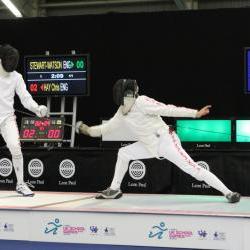Cool Downs for Fencers- A Major Rethink?

Last week I was talking to a couple of reasonable fencers (Louise Helyer- Commonwealth silver medallist, Drew Wilsher– Army Champion) about cool downs for fencers and why they should be different from other sports.
It was something that they had not come across, and was of interest as they both coach modern pentathletes- for whom it is perhaps even more important.
Fencing is a one sided sport- ipsilateral– and the actions predominantly work repeatedly on this same side.
Most actions in life are contralateral (opposite arm and leg) including running.
When looking at warm ups and cool downs, coaches have looked at things from a physiological perspective – heart rate, blood flow, core temperature and so on. In the warm ups technical drills and mental preparation will take place to prepare the fencer for competition.
But what about the motor control system and the reflexes associated with this?
The crossed extensor reflex (where one limb extends the other flexes) is a key part of walking and running, but has been interfered with whilst fencing. The fencing cool down should include some exercises that return the motor control system aback to its resting state ready for daily activity.
Examples might be:
- Walking- (fencers walk funny) emphasising swinging of the arms.
- Walking and lifting knee up high- touch with opposite elbow.
- Kneeling on the floor extending opposite arm and leg, then alternating sides.
- Press up position- bring left hand and right foot together undeneath the body, keeping your back flat. Repeat on the opposite side.
More of these and video clips can be found in the SportsTraining System
In the Modern Pentathlon World, after fencing for three hours, the athletes have a short break before starting on their combined run\shoot event. This is normally spent eating and drinking to aid recovery. But what about doing a few cool down drills that work contralaterally and restore the motor system to normality.
This will then help the athlete when they are warming up for their combined event.
Whilst it is very common to talk about “sport specific” training, these athletes don’t exist in a vacuum. They have to walk from A to B at the every least. So some thought should be given to adjusting back normal motor patterns as well as mental and physical recovery.
(The same could be said for weightlifting exercises that only operate bipedally in a sagittal plane- think about doing exercises afterwards that work contralaterally and involve movement. Heaven forbid that it might resemble some athletic movements!)
Further reading:

Very good, just a point to note that for mod pent the fence comes before swim, which comes before ride, which come before combined (don’t know if that would have any bearing on above?)
Hi,
at the last World Championships I attended in Crystal Palace, I was watching Arthur Lanigan O’Keeffe who swam, then fenced for 3 hours, then had the combined. The ride wasn’t until later and was for those who made the cut.
[…] Some better examples of cool downs using Fencing as an example are here […]
[…] How to cool down after fencing […]
[…] Fencing: Introducing fitness to fencers, fencing is a one sided sport, so fencers need special attention to preevnt imbalances and injury, also how to warm up for fencing, how to cool down after fencing […]